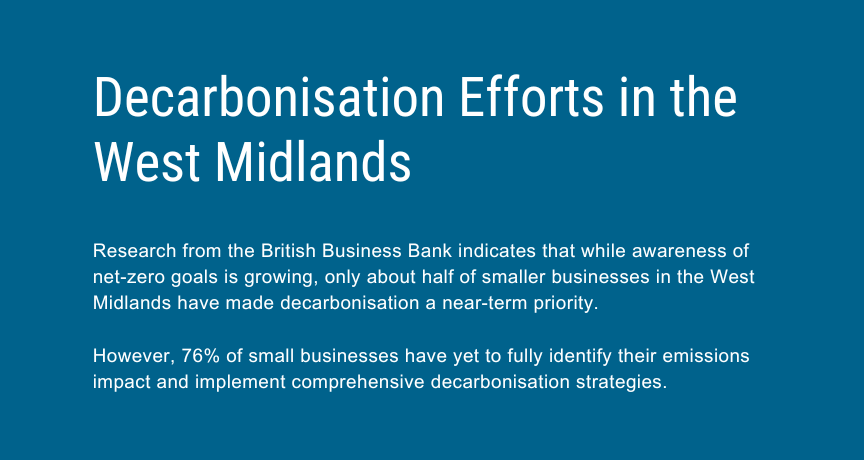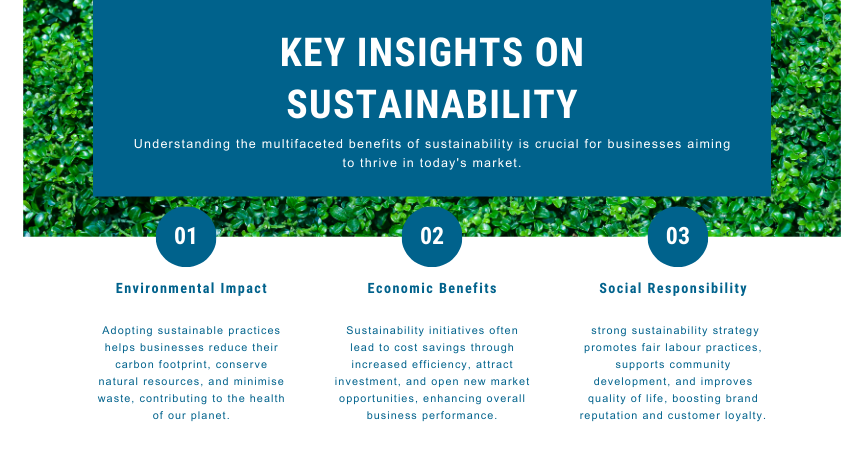Research indicates that businesses that place a strong emphasis on sustainability not only make a positive impact on the environment but also experience improved business performance and reputation.
With recent extreme weather events, such as the floods and storms impacting the West Midlands, the urgency for companies to adapt and innovate is clearer than ever.
Companies in the West Midlands can adapt their business models to integrate sustainable practices, ensuring they thrive despite environmental challenges.
This article examines whether businesses in the West Midlands are focusing enough on their sustainability strategy and explores the critical aspects of developing a successful approach.
We will discuss the definition and significance of sustainability strategies, the obstacles that businesses encounter, and practical measures to develop a successful plan.
Additionally, we will explore the impact of technology, regulation, and corporate culture on the development of a comprehensive sustainability strategy.
Definition and Importance of Sustainability Strategy
A sustainability strategy is a comprehensive plan that organisations develop to incorporate environmental, social, and economic factors into their operations and decision-making processes.
This strategy is an integral part of a modern business strategy that encompasses the triple bottom line—profit, people, and the planet—aiming to mitigate negative impacts on the planet while also making positive contributions to society and achieving economic viability.
Unlike traditional environmental approaches that focus solely on mitigating ecological damage, a sustainability strategy encompasses a broader perspective, including long-term resource management, ethical practices, and social responsibility.
Why Sustainability is Crucial for Modern Businesses
Sustainability is crucial for modern businesses as it reduces their environmental footprint, reduces waste, and conserves natural resources. It offers economic benefits, such as reduced operational costs and increased investment.
A robust sustainability strategy also promotes fair labour practices, community development, and quality of life.
A study by Nielsen found that 66% of global consumers are willing to pay more for products and services from companies committed to positive social and environmental impact.
Additionally, a robust sustainability strategy can provide a competitive advantage by attracting consumers who value environmental responsibility.
Recent Data on the Impact of Sustainability
Recent data underscores the significant impact of environmental sustainability on business performance and reputation:
Unilever
Unilever has been a leader in sustainability, with its Sustainable Living Plan aiming to decouple growth from environmental impact. The company reports that its sustainable brands, such as Dove and Hellmann’s, grow 69% faster than the rest of the business and deliver 75% of the company’s growth1. 2.
Marks & Spencer
Marks & Spencer’s Plan A initiative focuses on sustainability and ethical practices. The company has seen significant benefits, including cost savings from energy efficiency and waste reduction, as well as enhanced brand reputation. Plan A has helped M&S save over £750 million since its launch in 20072. 3.
BT Group
BT Group has committed to becoming a net-zero carbon emissions business by 2045. The company has already reduced its carbon emissions intensity by 57% since 2016. BT’s sustainability efforts have not only improved its environmental impact but also strengthened its reputation and customer loyalty3.
Challenges in Implementing a Sustainability Strategy
Implementing a sustainability strategy can offer numerous benefits, but businesses often face significant challenges along the way. Integrating environmental management systems can help overcome these challenges by optimizing and adapting existing processes to achieve sustainability goals.

1. Resource Constraints
One of the primary challenges is the allocation of resources. Sustainability initiatives often require substantial upfront investment in new technologies, training, and process changes.
For example, a small manufacturing company might struggle with the costs of upgrading to energy-efficient machinery, despite the long-term savings on energy bills.
The financial burden can be overwhelming for businesses operating with tight budgets or limited capital.
2. Resistance to Change
Another major hurdle is resistance to change within the organisation. Employees may be hesitant to adopt new practices, viewing them as disruptions to their established routines.
A retail chain, for instance, may encounter pushback when implementing new recycling programmes if employees perceive them as additional work or unnecessary. Overcoming this resistance requires careful management and communication.
3. Lack of Expertise
A lack of specialised knowledge can also impede progress. Developing and executing a sustainability strategy demands an understanding of regulatory requirements, best practices, and emerging technologies—areas in which many businesses lack in-house expertise.
A tech startup, for example, might struggle with creating a robust sustainability plan due to insufficient knowledge and difficulty accessing expert advice.
Best Practices for Developing a Sustainability Strategy
Creating a strong sustainability strategy is critical for organisations looking to succeed in today’s environmentally sensitive market. Following best practices, including adopting sustainable business practices, can assist you in developing an effective strategy that is aligned with your company objectives while also addressing environmental issues.
1. Define Clear Objectives
The foundation of any successful sustainability strategy is setting clear, actionable objectives.
Start by identifying the specific sustainability goals that align with your business's mission and values. This might include reducing carbon emissions, minimising waste, or improving energy efficiency.
2. Develop a Comprehensive Plan
Once objectives are set, develop a detailed plan outlining how you will achieve these goals. This plan should include the necessary actions, timelines, and resources required. Consider integrating the latest technologies and best practices into your strategy.
3. Implement and Monitor Progress
Implementing a successful sustainability strategy involves rolling out the plan in phases, regularly reviewing progress, using performance metrics and KPIs, and using tools like sustainability reporting software to efficiently track and analyse data.
4. Communicate and Report Results
Transparency is vital in sustainability efforts. Regularly communicate your progress and achievements to stakeholders, including employees, customers, and investors. This not only builds trust but also demonstrates your commitment to sustainability.
Annual sustainability reports can effectively showcase your results, highlight areas of improvement, and set future goals.
Learn from Successful Case Studies of Sustainable Business Practices
Learning from sustainable businesses can offer valuable insights and inspiration for developing your own sustainability strategy.
By examining how leading companies have excelled in their sustainability efforts, you can identify best practices and innovative approaches to integrate into your business.
Here are a few examples of companies that have successfully implemented sustainability strategies:
- Patagonia: Known for its environmental activism, Patagonia has integrated sustainability into every aspect of its business. The company uses recycled materials in its products, supports environmental causes, and encourages customers to repair and reuse their gear instead of buying new.
- IKEA: IKEA’s People & Planet Positive strategy focuses on sustainable sourcing, renewable energy, and waste reduction. The company aims to become climate positive by 2030 by reducing more greenhouse gas emissions than its value chain emits.
- Google: Google has been carbon neutral since 2007 and aims to run entirely on carbon-free energy by 2030. The company invests in renewable energy projects and uses AI to improve energy efficiency in its data centers.
- Microsoft: Microsoft has committed to becoming carbon negative by 2030, meaning it will remove more carbon from the environment than it emits. The company is also investing in carbon removal technologies and working to reduce its water usage and waste.
Advancing Sustainability through Technology and Innovation
Technology and innovation are crucial for enhancing sustainability in various industries, driving efficiencies, and reducing environmental footprints, contributing to a more sustainable future.

Energy Efficiency, Renewable Energy, and Carbon Emissions
One of the most significant ways technology supports sustainability is through advancements in energy efficiency and renewable energy sources.
Smart grids, energy-efficient lighting, and advanced HVAC systems help businesses reduce their energy consumption. For example:
- Smart Grids and Energy Management Systems: These technologies optimise energy use by providing real-time data and control over energy consumption. Companies like Siemens and Schneider Electric are leading the way in smart grid technology, which allows for better energy distribution and management, reducing waste and lowering costs.
- Renewable Energy Solutions: Solar panels, wind turbines, and bioenergy technologies enable businesses to generate clean energy. For instance, Google has committed to powering its data centres with 100% renewable energy, achieving this goal through investments in solar and wind projects worldwide.
Sustainable Manufacturing, Supply Chain, and Circular Economy
Innovations in manufacturing processes and the circular economy concept are transforming how businesses manage resources and waste. Technologies in this area include:
- 3D Printing and Additive Manufacturing: These technologies reduce material waste by using only the necessary amount of resources for production. Companies like HP and Stratasys are advancing 3D printing techniques that minimise waste and enable the production of complex, customised products with reduced environmental impact.
- Recycling and Upcycling Technologies: Innovations in recycling technologies help businesses repurpose waste materials into new products. For example, the company TerraCycle specialises in recycling hard-to-recycle waste, turning it into usable materials and products, thereby promoting a circular economy. Companies like IKEA and Patagonia use sustainable materials in their products to reduce environmental impact, showcasing how eco-friendly practices meet consumer demand and enhance business value.
Data Analytics and Artificial Intelligence
Data analytics and artificial intelligence (AI) play crucial roles in strengthening sustainability efforts by providing insights and predictive capabilities:
- Predictive Analytics: AI-powered predictive analytics help businesses anticipate and mitigate environmental impacts. For example, IBM's Watson can analyse data to predict equipment failures, allowing for proactive maintenance that prevents downtime and reduces waste.
- Supply Chain Optimisation: Advanced analytics tools enhance supply chain transparency and efficiency. Companies like SAP offer supply chain management solutions that track the sustainability of supply chains, helping businesses make more informed decisions about sourcing and logistics.
Sustainable Agriculture and Resource Management
Technology is also transforming agriculture and resource management, contributing to more sustainable practices:
- Precision Agriculture: Technologies such as drones, sensors, and GPS enable farmers to monitor and manage crops more effectively. For example, John Deere’s precision agriculture solutions use data to improve the use of water, fertilisers, and pesticides, reducing waste and environmental impact.
- Water Management Systems: Advanced water management technologies help businesses conserve water and manage resources efficiently. Systems like those developed by AquaSpy use soil moisture sensors to enhance irrigation practices, reduce water usage, and promote sustainable agriculture.
Green Building Technologies
Innovations in green building technologies contribute to creating sustainable and energy-efficient buildings:
- Building Information Modeling (BIM): BIM technology facilitates the design and construction of energy-efficient buildings by simulating and analysing the environmental impact of building designs. Companies like Autodesk offer BIM solutions that help architects and builders create more sustainable structures.
- Smart Building Systems: Technologies such as automated lighting, heating, and cooling systems enhance energy efficiency in buildings. For example, the Edge in Amsterdam uses smart technology to adjust energy use based on occupancy and weather conditions, achieving significant reductions in energy consumption.
Regulatory and Compliance Aspects
Understanding Sustainability Regulations and Standards
Understanding and adhering to regulations proves essential for businesses aiming to establish a strong sustainability strategy.
Adhering to relevant regulations and standards not only demonstrates legal compliance, but also highlights a dedication to ethical business practices.
Environmental Protection Legislation and Environmental Impact
- UK Emissions Trading Scheme (UK ETS): Following Brexit, the UK established its own Emissions Trading Scheme, which operates similarly to the EU ETS. Companies must monitor and report their carbon emissions and purchase allowances for emissions above a certain threshold, incentivizing reductions in greenhouse gas emissions.
- Environmental Protection Act 1990: This act provides the framework for waste management and control of emissions into the environment. Businesses must comply with regulations on waste disposal, air quality, and pollution control to minimize their environmental impact.
Corporate Social Responsibility (CSR) Standards
- Global Reporting Initiative (GRI): The GRI provides a framework for businesses to report on their economic, environmental, and social impacts. Adopting GRI standards helps companies communicate their sustainability performance transparently to stakeholders.
- Sustainability Accounting Standards Board (SASB): SASB standards focus on financially material sustainability topics across different industries. They guide businesses in disclosing sustainability information relevant to investors and financial analysts.

Climate Change Agreements
- Paris Agreement: The UK is a signatory to the Paris Agreement, which sets targets for reducing greenhouse gas emissions. Businesses are encouraged to align their sustainability strategies with national commitments under this agreement5.
- Science Based Targets Initiative (SBTi): The SBTi provides frameworks for businesses to set science-based emission reduction targets in line with climate science. Companies that commit to SBTi targets demonstrate leadership in climate action.
Industry-Specific Standards
- ISO 14001: Harvard Business School has emphasised the connection between sustainability efforts and business advantages, and ISO 14001 is a prime example. This international standard specifies requirements for an effective environmental management system (EMS). It helps businesses systematically manage their environmental responsibilities and improve environmental performance.
- BREEAM Certification: The Building Research Establishment Environmental Assessment Method (BREEAM) certification recognizes buildings that meet high standards for sustainability and energy efficiency. It’s a key certification for organizations aiming to build or renovate facilities sustainably.
Integrating Compliance into Your Sustainability Strategy
Ensuring compliance with environmental regulations is a critical component of any sustainability strategy. Here are key steps to help you effectively incorporate compliance into your sustainability initiatives:
- Establish Clear Compliance Goals -Identify relevant regulations and set compliance goals that align with these requirements, such as reducing your carbon footprint.
- Develop and Implement Policies - Create and document policies to ensure compliance, such as an environmental management system (EMS) aligned with ISO 14001. Communicate these policies across your organisation.
- Conduct Regular Audits and Assessments - Perform regular internal and external audits to evaluate compliance and identify areas for improvement. Evaluating waste production during these quality audits can help businesses achieve their sustainability goals while optimising their existing management systems.
- Engage and Train Employees - Provide regular training on sustainability regulations and best practices to foster a culture of compliance.
- Implement Technology - Use sustainability reporting software and real-time monitoring systems to track and manage your environmental impact.
- Communicate and Report Results - Regularly share your progress with stakeholders through reports and updates to build trust and demonstrate commitment to sustainability.
Sustainability Research and Collaboration at BCU
Join forces with Birmingham City University in our commitment to sustainability in business.
Through our research projects and collaborations, we work closely with businesses to develop innovative and sustainable practices.
Discover how partnering with BCU can help your business achieve its sustainability goals and drive positive environmental impact.






